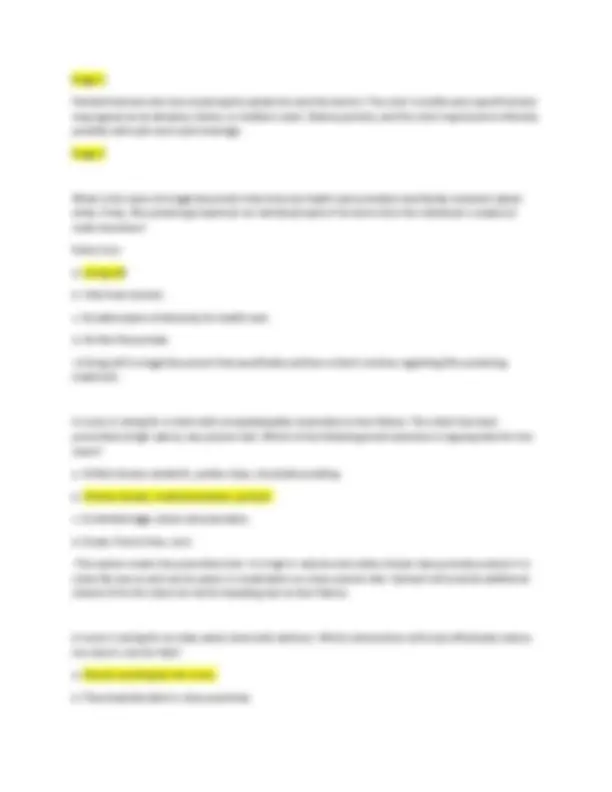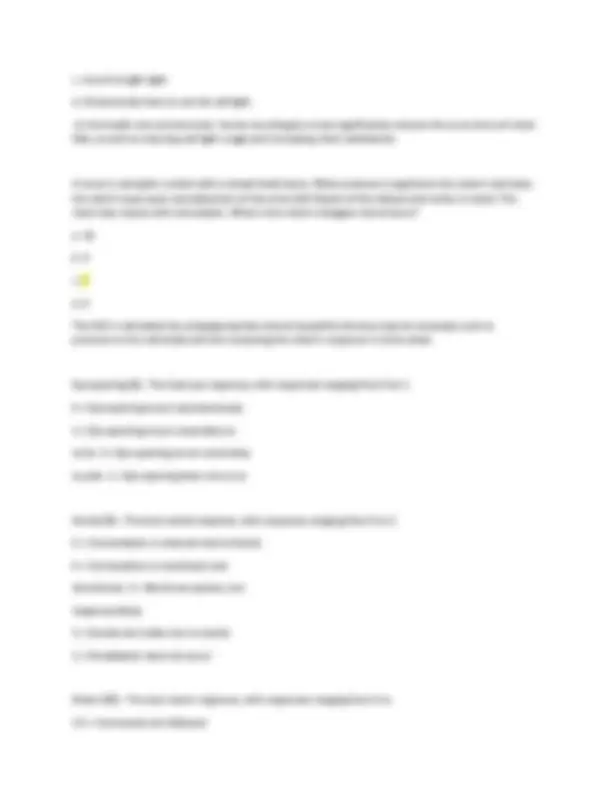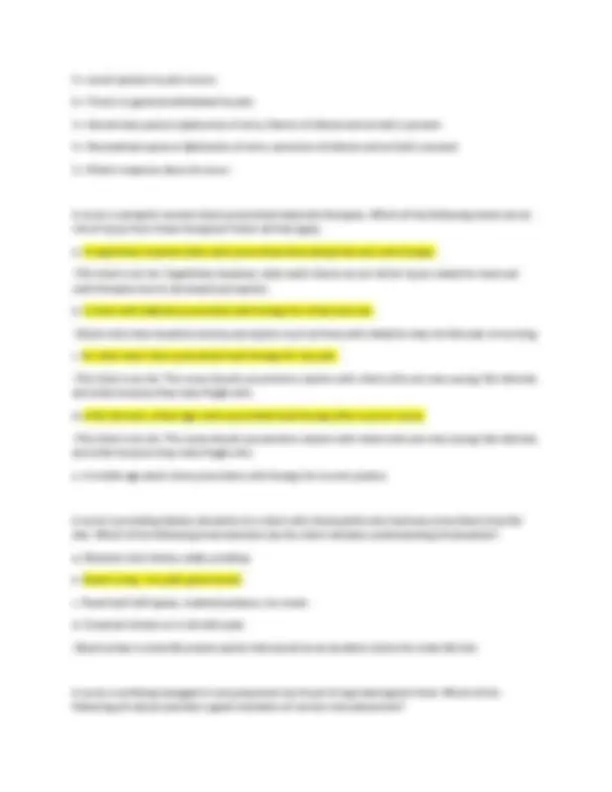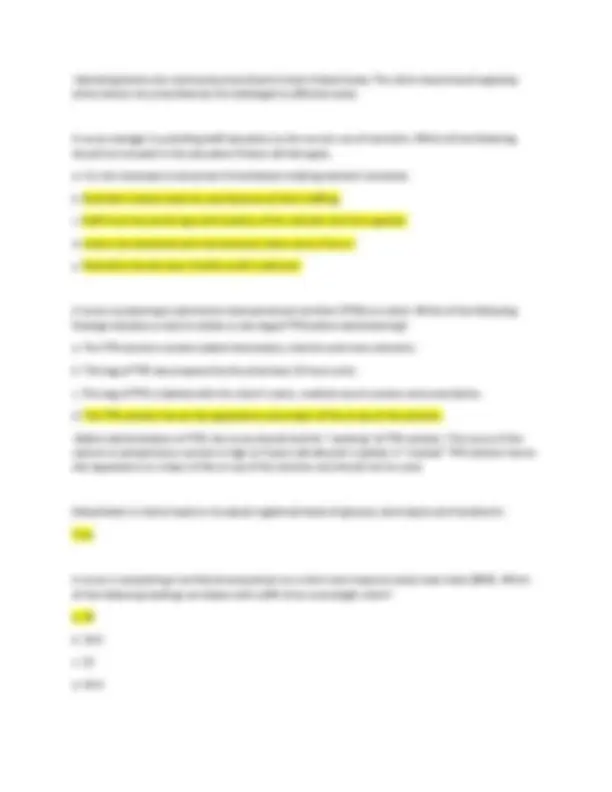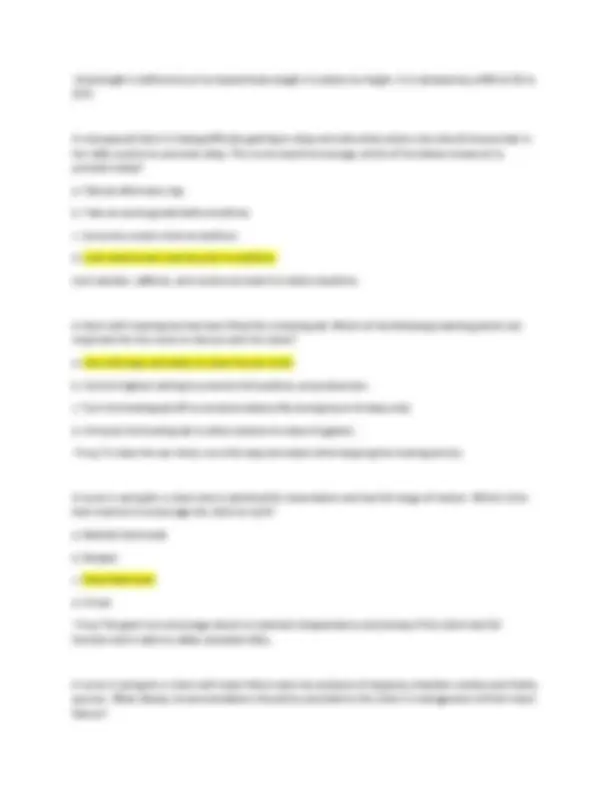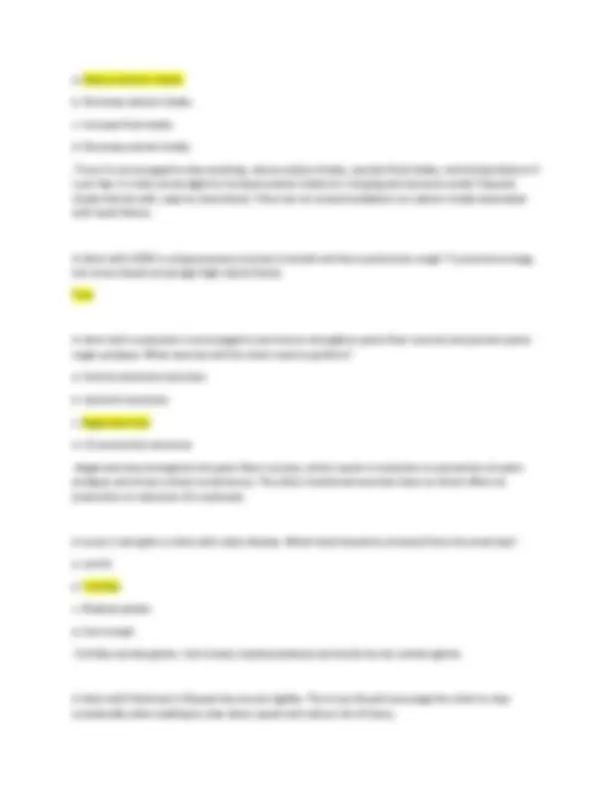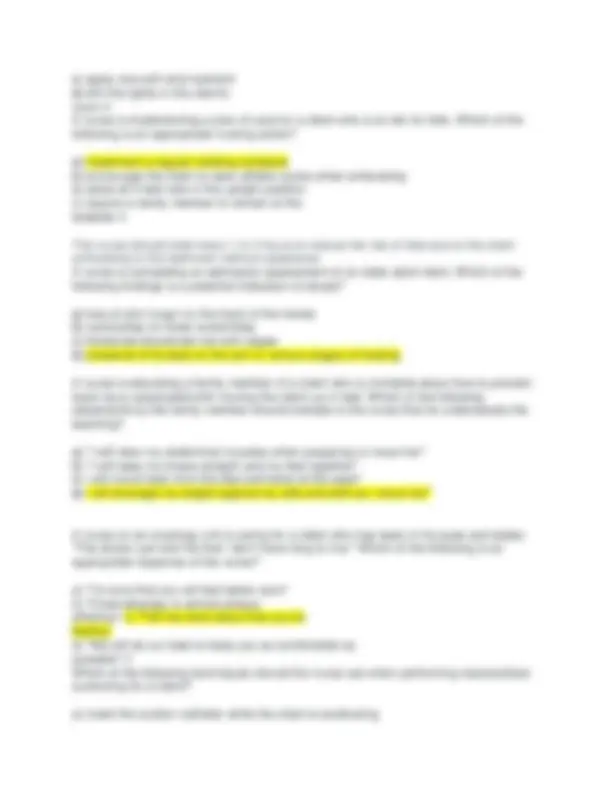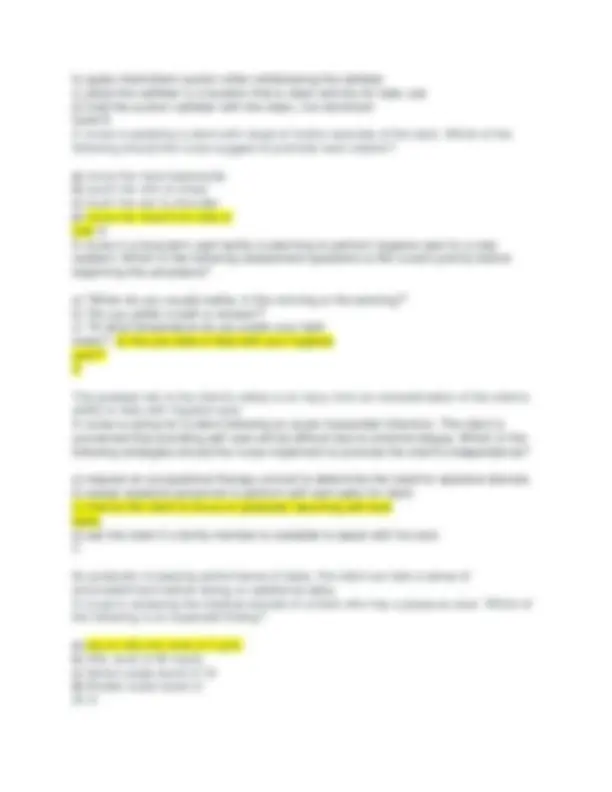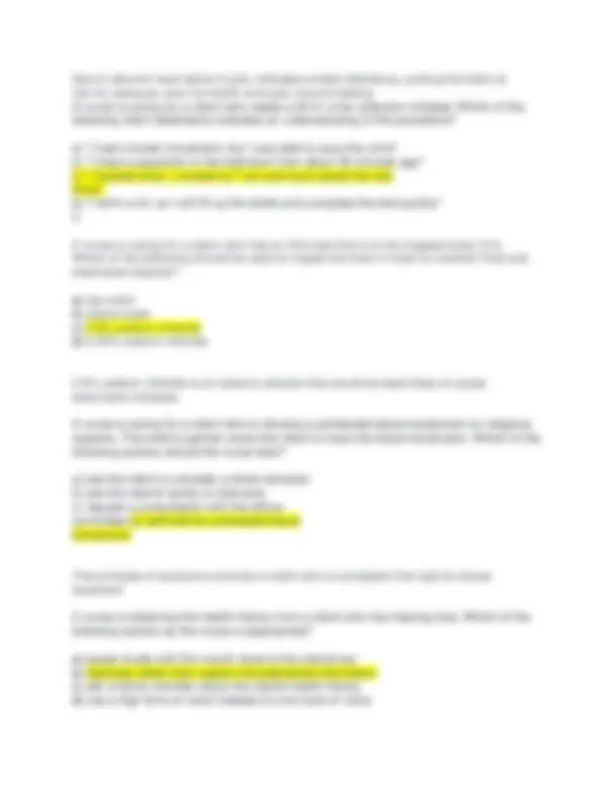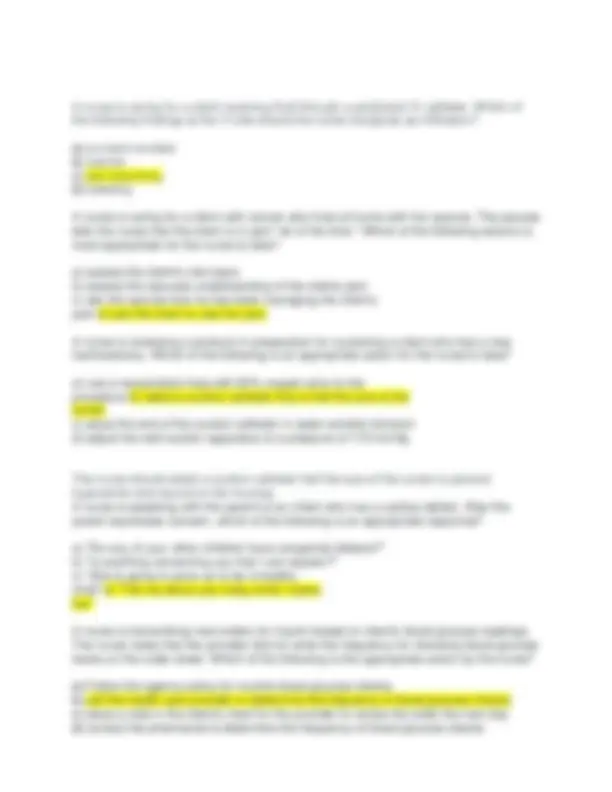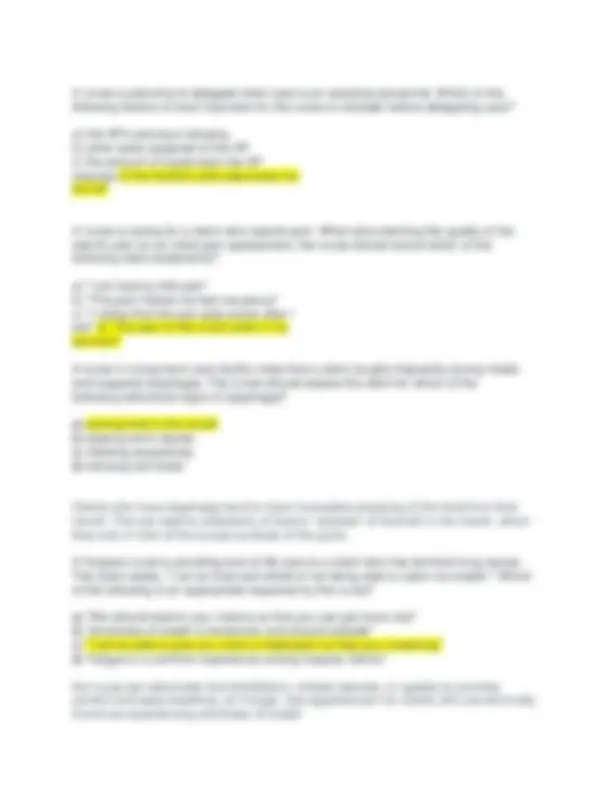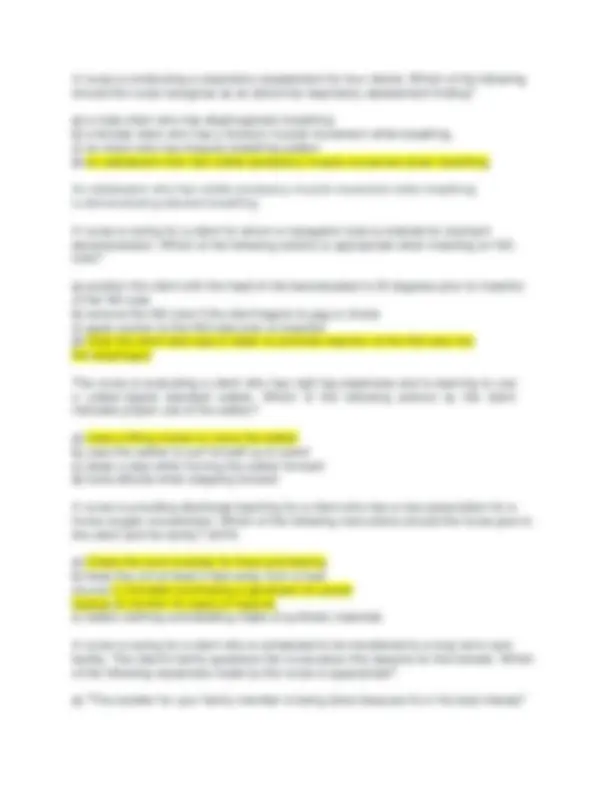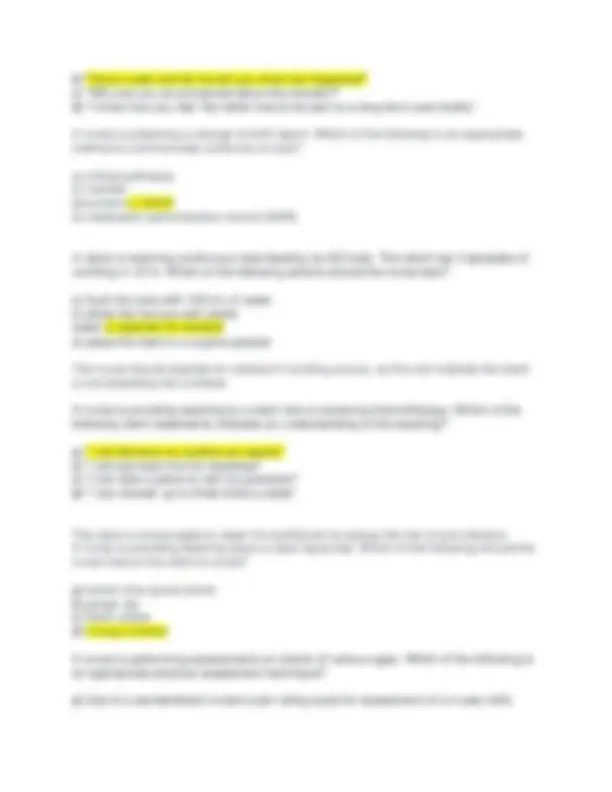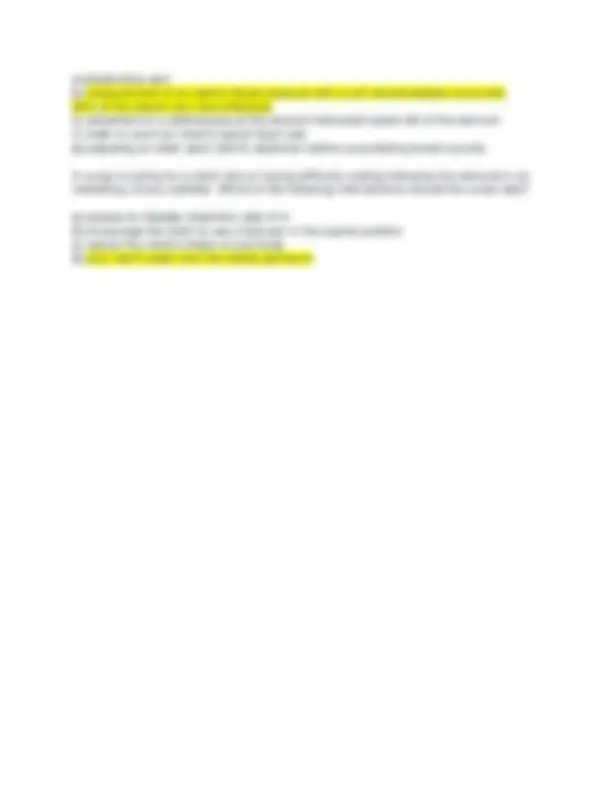Download ATI practice test fundamental Updated 2023-2024 and more Exams Nursing in PDF only on Docsity!
A nurse is providing education to a client with a fractured femur who will need to use crutches for the next 6 weeks. Identify if the following directions provided by the nurse for walking upstairs using crutches are true or false.
TRUE
- Hold to rail with one hand and crutches with the other hand.
- Push down on the stair rail and the crutches and step up with the 'unaffected' leg.
- If not allowed to place weight on the 'affected' leg, hop up with the 'unaffected' leg.
- Bring the 'affected' leg and the crutches up beside the 'unaffected' leg.
- Remember, the 'unaffected' leg goes up first and the crutches move with the 'affected' leg.
A client is prescribed antibiotic "A" 50 mg IV. The mixed IV solution contains 100 mL. The nurse is to administer the medication over ½ hour. The drip factor of the available IV tubing is 15gtt/mL. What is the drip rate in drops per minute?
50 gt t per minute
...
Match the development tasks with the correct age group.
Develop sense of personal identity that family expectations influence. Peer relationships develop as support system. Concerned with body images that media portray.
Adolescents 12 - 20 years
Take on new experiences and when unable to accomplish task may feel guilty or misbehave. Generally, do not exhibit stranger anxiety. Understand behavior in terms of what is socially acceptable.
Pre-schoolers 3 - 6 years
Develop sense of industry through advances in learning. Strive to develop healthy self- respect by finding out in what areas they excel. Peer groups play important role in social development.
School-age children 6 - 12 years
Personalize values and beliefs and base reasoning on ethical fairness principles. Establish close relationships. Have influences that help with formation of healthy self-concept, such family and friends.
Young adults 20 - 35 years
Match the following isolation precautions to the correct disease process.
Airborne precautions:
A private room.
-Masks or respiratory protection devices for caregivers and visitors.
-An N95 or high-efficiency particulate air (HEPA) respirator is used if the client is known or suspected to have tuberculosis.
-Negative pressure airflow exchange in the room of at least six exchanges per hour.
Measles
Contact precautions:
-A private room or a room with other clients with the same infection.
-Gloves and gowns worn by the caregivers and visitors.
Vancomycin resistant enterococcus (VRE)
Droplet precautions:
A private room or a room with other clients with the same infectious disease.
Masks for providers and visitors.
Pertussis
Match the description to the correct stage of pressure ulcer.
Full-thickness tissue loss with damage to or necrosis of subcutaneous tissue. The ulcer may extend down to, but not through, underlying fascia. The ulcer appears as a deep crater with or without undermining of adjacent tissue and without exposed muscle or bone. Drainage and infection are common.
Stage 3
Full-thickness tissue loss with destruction, tissue necrosis, or damage to muscle, bone, or supporting structures. There may be sinus tracts, deep pockets of infection, tunneling, undermining, eschar (black scab-like material), or slough (tan, yellow, or green scab-like material).
Stage 4
Intact skin with an area of persistent, no blanchable redness, typically over a bony prominence, that may feel warmer or cooler than the adjacent tissue. The tissue is swollen and has congestion, with possible discomfort at the site. With darker skin tones, the ulcer may appear blue or purple.
c. Use of a night-light.
d. Demonstrate how to use the call light.
-In the health care environment, hourly rounding by nurses significantly reduces the occurrence of client falls, as well as reducing call light usage and increasing client satisfaction.
A nurse is caring for a client with a closed head injury. When pressure is applied to the client's nail beds, the client's eyes open and adduction of the arms with flexion of the elbows and wrists is noted. The client also moans with stimulation. What is this client's Glasgow Coma Score?
a. 10
b. 4
c. 7
d. 9
The GCS is calculated by using appropriate stimuli (a painful stimulus may be necessary such as pressure to the nail beds) and then assessing the client's response in three areas.
Eye opening (E) - The best eye response, with responses ranging from 4 to 1
4 = Eye opening occurs spontaneously.
3 = Eye opening occurs secondary to
voice. 2 = Eye opening occurs secondary
to pain. 1 = Eye opening does not occur.
Verbal (V) - The best verbal response, with responses ranging from 5 to 1
5 = Conversation is coherent and oriented.
4 = Conversation is incoherent and
disoriented. 3 = Words are spoken, but
inappropriately.
2 = Sounds are made, but no words.
1 = Vocalization does not occur.
Motor (M) - The best motor response, with responses ranging from 6 to
1 6 = Commands are followed.
5 = Local reaction to pain occurs.
4 = There is a general withdrawal to pain.
3 = Decorticate posture (adduction of arms, flexion of elbows and wrists) is present.
2 = Decerebrate posture (abduction of arms, extension of elbows and wrists) is present.
1 = Motor response does not occur.
A nurse is caring for several clients prescribed heat/cold therapies. Which of the following clients are at risk of injury from these therapies? Select all that apply.
a. A cognitively impaired older adult prescribed alternating heat and cold therapy.
-This client is at risk. Cognitively impaired, older adult clients are at risk for injury related to heat and cold therapies due to decreased perception.
b. A client with diabetes prescribed cold therapy for a fractured toe.
-Clients who have impaired sensory perception such as those with diabetes may not feel pain or burning.
c. An older adult client prescribed heat therapy for hip pain.
-This client is at risk. The nurse should use extreme caution with clients who are very young, fair-skinned, and older because they have fragile skin.
d. A fair-skinned, school age client prescribed heat therapy after a soccer injury.
-This client is at risk. The nurse should use extreme caution with clients who are very young, fair-skinned, and older because they have fragile skin.
e. A middle age adult client prescribed cold therapy for muscle spasms.
A nurse is providing dietary education to a client with cholecystitis who has been prescribed a low-fat diet. Which of the following meal selections by the client indicates understanding of education?
a. Macaroni and cheese, salad, pudding
b. Roast turkey, rice pilaf, green beans
c. Roast beef with gravy, mashed potatoes, ice cream
d. Creamed chicken on a roll with peas
-Roast turkey is a low-fat protein option that would be an excellent choice for a low-fat diet.
A nurse is verifying nasogastric tube placement by the pH of aspirated gastric fluid. Which of the following pH values provides a good indication of correct tube placement?
-Clients prescribed potassium-wasting diuretics should be encouraged to eat foods high in potassium. Oranges, dried fruits, tomatoes, avocados, dried peas, meats, broccoli, and bananas are all good sources of potassium.
A nurse is assisting a client with his meal that is at risk for aspiration due to a stroke. What interventions should the nurse take to prevent aspiration? Select all that apply.
a. Support client's upper back, neck and head during feeding.
-The nurse should ensure adequate support of the client's upper body during feeding.
b. Position the client in Fowler's position.
-Positioning the client in Fowler's position or in a chair can help prevent aspiration.
c. Keep the client in semi-Fowler's position for at least 1 hour after the meal.
-Maintaining the client in a semi upright position following meals can prevent aspiration in the event of reflux.
d. Instruct the client to tuck his chin when swallowing.
-Tucking in the chin when swallowing can help propel food down the esophagus and prevent aspiration.
Which of the following can cause a low pulse oximetry reading?
a. Low altitudes
b. Increased hemoglobin level
c. Hyperthermia
d. Inadequate peripheral circulation
-Inadequate peripheral circulation can generate a low reading.
A nurse is caring for a client receiving radiation treatments for cancer. The client states he is experiencing dryness, redness and scaling at the treatment area. Which of the following should the nurse instruct the client to do?
a. Sit in the sun for 15 minutes per day.
b. Wash the affected area daily with antimicrobial soap.
c. Liberally apply prescribed lotion to the area.
d. Apply moist heat to the area twice daily.
-Hydrating lotions are commonly prescribed to treat irritated areas. The client should avoid applying other lotions not prescribed by the radiologist to affected areas.
A nurse manager is providing staff education on the correct use of restraints. Which of the following should be included in this education? Select all that apply.
a. It is not necessary to document the behaviors making restraint necessary.
b. Restraints should never be used because of short staffing.
c. Staff must document type and location of the restraint and time applied.
d. Assess neurovascular and neurosensory status every 2 hours.
e. Restraints should never interfere with treatment.
A nurse is preparing to administer total parenteral nutrition (TPN) to a client. Which of the following findings indicates a need to obtain a new bag of TPN before administering?
a. The TPN solution contains added electrolytes, vitamins and trace elements.
b. The bag of TPN was prepared by the pharmacy 12 hours prior.
c. The bag of TPN is labeled with the client's name, medical record number and prescription.
d. The TPN solution has an oily appearance and a layer of fat on top of the solution.
-Before administration of TPN, the nurse should look for "cracking" of TPN solution. This occurs if the calcium or phosphorous content is high or if poor-salt albumin is added. A "cracked" TPN solution has an oily appearance or a layer of fat on top of the solution and should not be used.
Dehydration in clients leads to increased registered levels of glucose, electrolytes and hematocrit.
True
A nurse is completing a nutritional assessment on a client and measures body mass index (BMI). Which of the following readings correlates with a BMI of an overweight client?
a. 25
b. 18.
c. 32
d. 24.
a. Reduce sodium intake.
b. Decrease calcium intake.
c. Increase fluid intake.
d. Decrease protein intake.
-True; It is encouraged to stop smoking, reduce sodium intake, monitor fluid intake, restricting intake to 2 L per day. It is also encouraged to increase protein intake to 1.12 g/kg and consume small, frequent meals that are soft, easy-to-chew foods. There are no recommendations on calcium intake associated with heart failure.
A client with COPD is using accessory muscles to breath and has a productive cough. To promote energy, the nurse should encourage high-calorie foods.
True
A client with a cystocele is encouraged to exercise to strengthen pelvic floor muscles and prevent pelvic organ prolapse. What exercise will the client need to perform?
a. Uterine extension exercises
b. Isometric exercises
c. Kegel exercises
d. Circumduction exercises
-Kegel exercises strengthen the pelvic floor muscles, which results in reduction or prevention of pelvic prolapse and stress urinary incontinence. The other mentioned exercises have no direct effect on prevention or reduction of a cystocele.
A nurse is caring for a client with celiac disease. Which food should be removed from the meal tray?
a. Lentils
b. Tortillas
c. Mashed potato
d. Corn bread
-Tortillas contain gluten. Corn bread, mashed potatoes and lentils do not contain gluten.
A client with Parkinson's Disease has muscle rigidity. The nurse should encourage the client to stop occasionally when walking to slow down speed and reduce risk of injury.
True
A nurse is preparing to insert an IV catheter into a client's arm prior to initiating IV fluid
therapy. Which of the following interventions should the nurse implement to prevent
infection?
a) Thread the IV catheter so that the hub rests at the insertion site
b) Shave excess hair from around the insertion site
c) Cleanse the site with hydrogen peroxide before IV catheter insertion
d) Palpate the site carefully just before inserting the IV catheter
-Inserting the catheter up to the hub reduces the risk of contaminating along the length
of the catheter
A nurse is caring for a postoperative adult client who refuses to use an incentive
spirometer following major abdominal surgery. Which of the following is the nurse's
priority action?
a) Request that a respiratory therapist discuss the technique for incentive spirometry
b) Administer a pain medication to the client
c) Chart the client's refusal to participate in health restorative activities
d) Determine the reasons why the client is refusing the use the incentive spirometer
A nurse is preparing to administer meperidine (Demerol) 80 mg IM from a 100 mg
prefilled syringe. After the injection, which of the following is an appropriate action by the
nurse?
a) Return the unused portion to the pharmacy
b) Have another nurse witness the disposal of the excess medication
c) Place the syringe with the unused portion in a locked medication drawer
d) Discard the unused medication in the sharps container
-meperidine is a controlled substance
A nurse is caring for a client who has tuberculosis. Which of the following actions should
the nurse take? SATA
a) Place the client in a negative pressure room
b) wear gloves when assisting the client with oral care
c) limit each visitor to 2 hr increments
d) wear a surgical mask when providing care
e) Use antimicrobial sanitizer for hand
hygiene
c) apply one soft wrist restraint
d) dim the lights in the client's
room A
A nurse is implementing a plan of care for a client who is at risk for falls. Which of the
following is an appropriate nursing action?
a) implement a regular toileting schedule
b) encourage the client to wear athletic socks when ambulating
c) place all 4 bed rails in the upright position
c) require a family member to remain at the
bedside A
The nurse should toilet every 1 to 3 hours to reduce the risk of falls due to the client
ambulating to the bathroom without assistance
A nurse is completing an admission assessment of an older adult client. Which of the
following findings is a potential indication of abuse?
a) loss of skin turgor on the back of the hands
b) varicosities on lower extremities
c) thickened discolored nail with ridges
d) presence of bruises on the arm in various stages of healing
A nurse is educating a family member of a client who is immobile about how to prevent
back injury associated with moving the client up in bed. Which of the following
statements by the family member should indicate to the nurse that he understands the
teaching?
a) "I will relax my abdominal muscles when preparing to move her"
b) "I will keep my knees straight and my feet together"
c) I will move back from the bed and bend at the waist"
d) I will leverage my weight against my wife and shift as I move her"
A nurse on an oncology unit is caring for a client who has tears in his eyes and states
"The doctor just told me that I don't have long to live." Which of the following is an
appropriate response of the nurse?
a) "I'm sure that you will feel better soon"
b) "Chemotherapy is almost always
effective" c) "Tell me more about how you're
feeling"
d) "We will do our best to keep you as comfortable as
possible" C
Which of the following techniques should the nurse use when performing nasotracheal
suctioning for a client?
a) insert the suction catheter while the client is swallowing
b) apply intermittent suction when withdrawing the catheter
c) place the catheter in a location that is clean and dry for later use
d) hold the suction catheter with the clean, non-dominant
hand B
A nurse is assisting a client with range of motion exercise of the neck. Which of the
following should the nurse suggest to promote neck rotation?
a) move her neck backwards
b) touch her chin to chest
c) touch her ear to shoulder
d) move her head from side to
side D
A nurse in a long-term care facility is planning to perform hygiene care for a new
resident. Which of the following assessment questions is the nurse's priority before
beginning this procedure?
a) "When do you usually bathe, in the morning or the evening?"
b) "Do you prefer a bath or shower?"
c) "At what temperature do you prefer your bath
water?" d) Are you able to help with your hygiene
care?"
D
The greatest risk to the client's safety is an injury from an overestimation of the client's
ability to help with hygiene care.
A nurse is caring for a client following an acute myocardial infarction. The client is
concerned that providing self-care will be difficult due to extreme fatigue. Which of the
following strategies should the nurse implement to promote the client's independence?
a) request an occupational therapy consult to determine the need for assistive devices
b) assign assistive personnel to perform self-care tasks for client
c) instruct the client to focus on gradually resuming self-care
tasks
d) ask the client if a family member is available to assist with his care
C
By gradually increasing performance of tasks, the client can feel a sense of
accomplishment before taking on additional tasks.
A nurse is reviewing the medical records of a client who has a pressure ulcer. Which of
the following is an expected finding?
a) serum albumin level of 3 g/dL
b) HDL level of 90 mg/dL
c) Norton scale score of 18
d) Braden scale score of
20 A
A nurse is performing a Romberg's test during the physical assessment of the client.
Which of the following should the nurse use?
a) touch the face with a cotton ball
b) apply a vibrating tuning fork to the clients forehead
c) have the client stand with arms at side and feet together
d) perform direct percussion over the area of the kidneys
Romberg's test assesses for alterations in balance therefore, the nurse should observe
for swaying and a loss of balance
A nurse planning care of an adolescent who is postoperative following a lumbar
laminectomy. Which of the following interventions should the nurse include in the plan of
care?
a) limit the adolescent's visitors
b) select the adolescent's food choices
c) allow the adolescent to make decisions regarding the daily routine
d) encourage the adolescent's parents to assist with personal hygiene
A nurse is caring for a client who has taken in 2,600 mL of fluids in 24 hr. Which of the
following is an expected output for the client?
a) 1,800 mL
b) 2,100 mL
c) 2,500 mL
d) 3,200 mL
The client's output should approximate the daily fluid intake
A nurse is reinforcing teaching regarding the use of a cane to a client who has left-leg
weakness. Which of the following should the nurse include in the teaching?
a) use the cane on the weak side of the body
b) advance the cane and the atrong leg
simultaneously c) maintain two points of support on
the floor
d) advance the cane 30 to 45 cm (12-18 in) with each step
Which of the following should indicate to a nurse the need to suction a client's
tracheostomy?
a) irritability
b) hypotension
c) flushing
d) bradycardia
Irritability is a sign that indicates the client has decreased oxygen to the tissues and the
nurse should suction the tracheostomy
A nurse is caring for a client who has left-sided paralysis after a cerebrovascular
accident. The client is unable to bear down his own weight. Which of the following
actions is an appropriate method to move the client from his bed to wheelchair?
a) Use a draw sheet and have two assistive personel help move the client
b) use a hydraulic life and have an AP help move the client
c) obtain a transfer belt and have two AP help move the client
d) help the client stand and then pivot to the wheelchair with assistance of the AP
A nurse is caring for a client who has a prescription for wound irrigation. Which of the
following actions should the nurse take?
a) wear sterile gloves when removing the old dressing
b) warm the irrigation solution to 40.5C (105F)
c) cleanse the wound from the center
outwards
d) use a 20 mL syringe to irrigate the
wound C
A nurse is caring for a client in the immediate postoperative period. The nurse should
recognize that which of the following positions moximizes the effectiveness of incentive
spirometry?
a) side-lying
b) supine
c) semi-fowler's
d) trandelenburg
HOB raised approximately 30 degrees allows for maximum expansion of the lungs
Which of the following precautions is important to take when a nurse is caring for a
client who has diarrhea due to Shingella?
a) have the client wear a mask when receiving
visitors b) wash hands before and after client contact
c) assign the client to a room with negative pressure air flow
d) instruct all visitors to limit time with the clientB
A nurse is reviewing practice guidelines with a group of newly licensed nurses. Which of
the following interventions falls within the RN scope of practice?
a) insert an implanted port
b) close a laceration with sutures
c) place an endotracheal tube
d) initiate and enteral feeding through a PEG tube
A nurse is planning to delegate client care to an assistive personnel. Which of the
following factors is most important for the nurse to consider before delegating care?
a) the AP's previous trainging
b) other tasks assigned to the AP
c) the amount of supervision the AP
requires d) the facility's jobb description for
the AP
A nurse is caring for a client who reports pain. When documenting the quality of the
client's pain on an initial pain assessment, the nurse should record which of the
following client statements?
a) "I am having mild pain"
b) "The pain makes me feel nauseous"
c) "I notice that the pain gets worse after I
eat" d) "The pain is like a dull ache in my
stomach"
A nurse in a long-term care facility notes that a client coughs frequently during meals
and suspects dysphagia. The nurse should assess the client for which of the
following behavioral signs of dysphagia?
a) storing food in the mouth
b) sipping warm liquids
c) chewing excessively
d) refusing soft foods
Clients who have dysphagia tend to have incomplete emptying of the food from their
mouth. This can lead to collections of food or "pockets" of food left in the mouth, which
they tuck in front of the buccal surfaces of the gums
A hospice nurse is providing end-of-life care to a client who has terminal lung cancer.
The client states, "I am so tired and afraid of not being able to catch my breath." Which
of the following is an appropriate response by the nurse?
a) "We should restrict your visitors so that you can get more rest"
b) "shortness of breath is temporary and should subside"
c) "I will be able to give you more a medication to help your breathing"
d) "fatigue is a common experience among hospice clients"
the nurse can administer bronchodilators, inhaled steroids, or opiates to promote
comfort and ease breathing, air hunger, and apprehension for clients who are terminally
ill and are experiencing shortness of breath
A nurse is conducting a respiratory assessment for four clients. Which of the following
should the nurse recognize as an abnormal respiratory assessment finding?
a) a male client who has diaphragmatic breathing
b) a female client who has a thoracic muscle movement while breathing
c) an infant who has irregular breathing pattern
d) an adolescent who has visible accessory muscle movement when breathing
An adolescent who has visible accessory muscle movement when breathing
is demonstrating labored breathing
A nurse is caring for a client for whom a nasogatric tube is ordered for stomach
decompression. Which of the following actions is appropriate when inserting an NG
tube?
a) position the client with the head of the bed elevated to 30 degrees prior to insertion
of the NG tube
b) remove the NG tube if the client begins to gag or choke
c) apply suction to the NG tube prior to insertion
d) have the client take sips of water to promote insertion of the NG tube into
the esophagus
The nurse is evaluating a client who has right leg weakness and is learning to use
a rubber-tipped standard walker. Which of the following actions by the client
indicates proper use of the walker?
a) Uses a lifting motion to move the walker
b) uses the walker to pull himself up to stand
c) takes a step while moving the walker forward
d) locks elbows when stepping forward
A nurse is providing discharge teaching for a client who has a new prescription for a
home oxygen concentrator. Which of the following instructions should the nurse give to
the client and his family? SATA
a) Check the cord routinely for frays and tearing
b) keep the unit at least 4 feet away from a heat
source c) Consider purchasing a generator for power
backup d) monitor for signs of hypoxia
e) Select clothing and bedding made of synthetic materials
A nurse is caring for a client who is scheduled to be transferred to a long-term care
facility. The client's family questions the nurse about the reasons for the transfer. Which
of the following reposnses made by the nurse is apporpriate?
a) "The transfer for your family member is being done because it's in his best interest"

